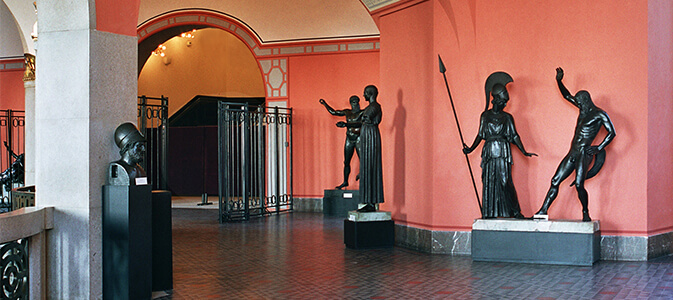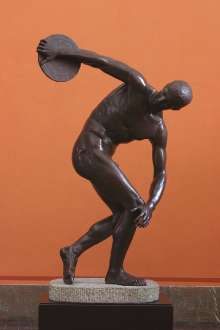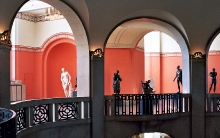The exhibition shows Europe’s largest collection of reconstructions of famous antique bronze statues, complemented by ancient ceramics. It owes its uniqueness not only to its greatness, but also to exceptional relation between the artworks and the exhibition space.
The exhibition shows Europe’s largest collection of reconstructions of famous antique bronze statues, complemented by ancient ceramics. It owes its uniqueness not only to its greatness, but also to exceptional relation between the artworks and the exhibition space.
The tradition of Szczecin’s antique collection dates back to late 19th century. Its initiator was Heinrich Dohrn (1838–1913), outstanding naturalist, humanist and collector. Artworks collected by him became the basis of the collection of the City Museum (Stadtmuseum), opened in 1913 on account of, among others, his crucial contribution. Besides, Dohrn encouraged numerous Szczecin patrician families to involve in creating great antique art exhibition.
His idea was to portray the roots of European culture in the museum exposition. The exhibition planned in such way included extraordinary collection of vases and small visual artworks, as well, as collection of reconstructions of the most famous antique sculptures, which have been lost over centuries and are known only from their copies. The exhibition was placed in a stately hall of the City Museum, designed especially for this purpose. The primal design of the lobby, the hall and domed hall of the museum faded away in 1940s, and Dohrn’s collection, as a result of World War II, was dispersed.
After 1945 the objects which have survived the war were lent to the National Museum in Warsaw and returned in 1994. The designers of the new exhibition decided to refer to the primal idea of the ancient art exhibition. In 2002 and 2003 the conservation team of the National Museum in Szczecin carried out a complete reconstruction of polychromy of the stately hall. Luckily, the interior retained majority of old architectural design – from marble pedestal facings to lamp settings and bars made of polished bronze. Works of ancient art exhibited in the hall excellently correspond to the surrounding architecture, decorating it and, at the same time, gaining worthy surrounding.
The way of exhibiting and describing the objects illustrates – according to the intentions of the creators of the primal exhibition: Heinrich Dohrn, Adolf Furtwängler and Walter Riezler – the heyday of Greek art, covering the 5th and 4th centuries B.C., as well, as Hellenistic period (4th – 1st centuries B.C.). The exhibition aims at introducing the ancient culture in its aesthetic dimension to contemporary viewer. The layout of the statues illustrates main motives in Greek sculpture from the classical to the Augustinian period.
The descriptions of the objects include – apart from the issues of the authorship, times and places of creation of the artworks – also mythological plots, origins of the characters’ names and their mythological roles and the most important relations to literature. Moreover, the descriptions include the history of the collection, informing when and where the copies have been made and – in cases of the most important reconstructions – indicating their sources. There is also information regarding the meaning of particular objects for the view of ancient period among the collection’s creators, that is at the turn of the 19th and the 20th centuries.
One of the most precious works in the exhibition is a reconstruction of a statue by Polykleitos – Doryphoros – important due to both the meaning of the original, as well, as the quality of the copy, Szczecin collection's only monumental full cast – made in traditional way and carved. Probably most famous sculpture of ancient Greece was created by Polykleitos as an illustration of the Kanon and rules of composition of ideal human image. The great meaning of the Kanon – affecting the art up to the present – made Doryphoros one of the ancient artworks that are most frequently referred to.
- Doryforos, rekonstrukcja rzeźby Polikleta z Argos z ok. 450–440 p.n.e., wykonana przez Georga Römera, Berlin 1910–1912, odlew w brązie
- Author: No Data
- Atena i Marsjasz, rekonstrukcja rzeźby Myrona z Eleuterii z ok. 457–447 r. p.n.e., wykonana w WMF Geislingen (Niemcy), 1904–1909, brąz
- Author: No Data
- Dyskobol, rekonstrukcja rzeźby Myrona z Eleuterii z ok. 460–450 r. p.n.e., wykonana w WMF Geislingen (Niemcy), 1905–1909, brąz
- Author: No Data
- Afrodyta Knidyjska, rekonstrukcja rzeźby Praksytelesa z Aten z 364–361 p.n.e., wykonana przez Hansa Everdinga, Rzym, 1905–1909, marmur
- Author: No Data
- Perykles, popiersie, kopia według rzeźby Kresilasa z Aten z ok. 440–430 r. p.n.e., wykonana w WMF Geislingen (Niemcy), 1905–1909, brąz
- Author: No Data








